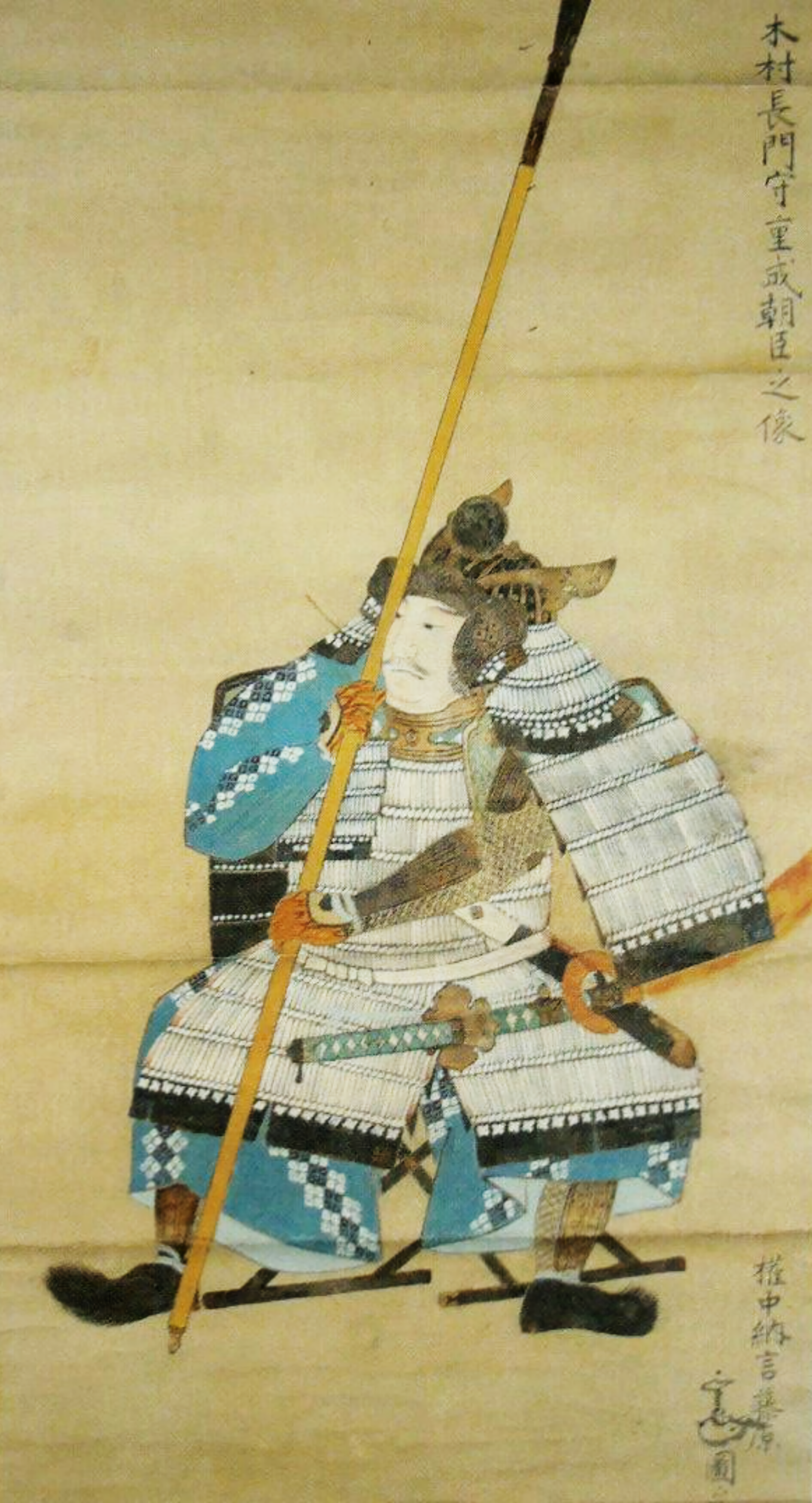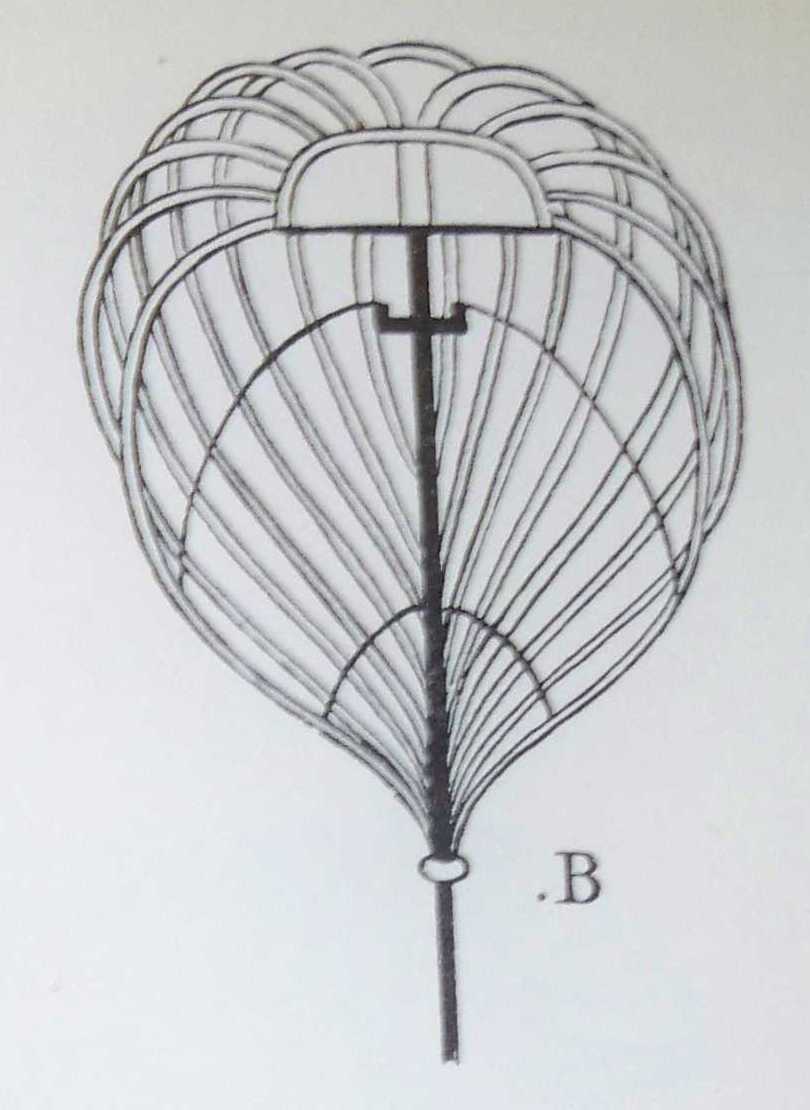|
Kimura Shigenari
was a Japanese samurai of the early Edo period. A retainer of the Toyotomi clan, Shigenari fought at the Siege of Osaka (leading Toyotomi forces at the Battle of Imafuku) and died in battle. Kimura Shigenari was a son of Kimura Shigekore, also known as Kimura Hitachi no suke (vice-governor of Hitachi), one of the chief counselors of Toyotomi Hidetsugu, but much of his origin remains uncertain. His mother was Toyotomi Hideyori's wetnurse: that was why Shigenari was able to become Hideyori's page at an early age and his vassal later. At the Winter Siege of Osaka (1614), his first campaign, Shigenari commanded an army as a general and fought well. In recognition of his distinguished deed in that battle Hideyori bestowed on him a testimonial that acclaimed him as the “peerless hero of the nation”, together with a short sword made by Masamune, the famous swordsmith. However, he returned those rewards immediately, because of his loyalty and absolute trust in the Toyotomi family. ... [...More Info...] [...Related Items...] OR: [Wikipedia] [Google] [Baidu] |
Samurai
were the hereditary military nobility and officer caste of medieval and early-modern Japan from the late 12th century until their abolition in 1876. They were the well-paid retainers of the '' daimyo'' (the great feudal landholders). They had high prestige and special privileges such as wearing two swords and ''Kiri-sute gomen'' (right to kill anyone of a lower class in certain situations). They cultivated the '' bushido'' codes of martial virtues, indifference to pain, and unflinching loyalty, engaging in many local battles. Though they had predecessors in earlier military and administrative officers, the samurai truly emerged during the Kamakura shogunate, ruling from 1185 to 1333. They became the ruling political class, with significant power but also significant responsibility. During the 13th century, the samurai proved themselves as adept warriors against the invading Mongols. During the peaceful Edo period (1603 to 1868), they became the stewards and chamberlains of ... [...More Info...] [...Related Items...] OR: [Wikipedia] [Google] [Baidu] |
Edo Period
The or is the period between 1603 and 1867 in the history of Japan, when Japan was under the rule of the Tokugawa shogunate and the country's 300 regional '' daimyo''. Emerging from the chaos of the Sengoku period, the Edo period was characterized by economic growth, strict social order, isolationist foreign policies, a stable population, perpetual peace, and popular enjoyment of arts and culture. The period derives its name from Edo (now Tokyo), where on March 24, 1603, the shogunate was officially established by Tokugawa Ieyasu. The period came to an end with the Meiji Restoration and the Boshin War, which restored imperial rule to Japan. Consolidation of the shogunate The Edo period or Tokugawa period is the period between 1603 and 1867 in the history of Japan, when Japan was under the rule of the Tokugawa shogunate and the country's regional '' daimyo''. A revolution took place from the time of the Kamakura shogunate, which existed with the Tennō's court, to the Tok ... [...More Info...] [...Related Items...] OR: [Wikipedia] [Google] [Baidu] |
Toyotomi Clan
The was a Japanese clan that ruled over the Japanese before the Edo period. Unity and conflict The most influential figure within the Toyotomi was Toyotomi Hideyoshi, one of the three "unifiers of Japan". Oda Nobunaga was another primary unifier and the ruler of the Oda clan at the time. Hideyoshi joined Nobunaga at a young age, but was not highly regarded because of his peasant background. Nevertheless, Hideyoshi's increasing influence allowed him to seize a significant degree of power from the Oda clan following Oda Nobunaga's death in 1582. As the virtual ruler of most of Japan, Hideyoshi received the new clan name "Toyotomi" in 1585 from the emperor, and achieved the unification of Japan in 1590. When Hideyoshi died in 1598, his son Toyotomi Hideyori was only five years old. Five regents were appointed to rule until his maturity, and conflicts among them began quickly. In 1600, Tokugawa Ieyasu deposed Hideyori and took power after winning the Battle of Sekigahara. In 161 ... [...More Info...] [...Related Items...] OR: [Wikipedia] [Google] [Baidu] |
Siege Of Osaka
The was a series of battles undertaken by the Japanese Tokugawa shogunate against the Toyotomi clan, and ending in that clan's destruction. Divided into two stages (winter campaign and summer campaign), and lasting from 1614 to 1615, the siege put an end to the last major armed opposition to the shogunate's establishment. The end of the conflict is sometimes called the , because the era name was changed from Keichō to Genna immediately following the siege. Background When Toyotomi Hideyoshi died in 1598, Japan came to be governed by the Council of Five Elders, among whom Tokugawa Ieyasu possessed the most authority. After defeating Ishida Mitsunari in the battle of Sekigahara in 1600, Ieyasu essentially seized control of Japan for himself, and abolished the Council. In 1603, the Tokugawa shogunate was established, with its capital at Edo. Hideyori and his mother Yodo-dono were allowed to stay at Osaka Castle, a fortress that had served as Hideyoshi's residence and he f ... [...More Info...] [...Related Items...] OR: [Wikipedia] [Google] [Baidu] |
Battle Of Imafuku
The was fought in late November 1614 between the forces of Tokugawa Ieyasu and the Toyotomi clan. This battle was one of the first of the series of battles fought near Osaka over the course of two years. The village of Imafuku stood on the northeast approach to Osaka, and so Tokugawa Ieyasu sent 1500 men under the command of Satake Yoshinobu to secure the site for a fort. They faced off against 600 men loyal to the Toyotomi "Western Army," under two generals named Iida and Yado. After Satake routed the defenders from the village and killed Iida, reinforcements from the Western Army arrived. Kimura Shigenari and Gotō Mototsugu led a charge, incurring major casualties on the Eastern force and forcing Satake to call a withdrawal. However, in the end, the Western forces were forced back once more after Uesugi Kagekatsu was a Japanese samurai ''daimyō'' during the Sengoku and Edo periods. He was the adopted son of Uesugi Kenshin and Uesugi Kagetora’s brother in law. Early ... [...More Info...] [...Related Items...] OR: [Wikipedia] [Google] [Baidu] |
Kimura Shigekore
was a Japanese samurai of the Azuchi-Momoyama period, who served the Toyotomi clan. He had been rewarded for his service in Toyotomi Hideyoshi's Korean campaign but then was implicated in a plot against Hideyoshi by Toyotomi Hidetsugu and forced to commit seppuku. His son, Kimura Shigenari, was a commander under Hideyoshi and Toyotomi Hideyoshi , otherwise known as and , was a Japanese samurai and ''daimyō'' (feudal lord) of the late Sengoku period regarded as the second "Great Unifier" of Japan.Richard Holmes, The World Atlas of Warfare: Military Innovations that Changed the Cour .... References Samurai 1595 deaths Year of birth unknown {{samurai-stub ... [...More Info...] [...Related Items...] OR: [Wikipedia] [Google] [Baidu] |
Masamune
, was a medieval Japanese blacksmith widely acclaimed as Japan's greatest swordsmith. He created swords and daggers, known in Japanese as ''tachi'' and ''tantō'', in the ''Sōshū'' school. However, many of his forged ''tachi'' were made into ''katana'' by cutting the tang (''nakago'') in later times. For this reason, his only existing works are ''katana'' and ''tantō''.相州伝の名工「正宗」. Nagoya Japanese Sword Museum Touken World. No exact dates are known for Masamune's life. It is generally agreed that he made most of his swords between 1288 and 1328. Some stories list his family name as Okazaki, but some experts believe this is a fabrication to enhance the standing of the |
Horo (cloak)
A was a type of cloak or garment attached to the back of the armour worn by samurai on the battlefields of feudal Japan. Description A ''horo'' was around 1.8 m (6 ft) long and made from several strips of cloth sewn together with a fringe on the top and bottom edges. The cloth strips were sewn together and formed into a sort of bag which would fill with air like a balloon when the wearer was riding a horse. A light framework of wicker, bamboo or whale bone known as an ''oikago'', similar to a crinoline, which is said to have been invented by Hatakeyama Masanaga during the Ōnin War (1467–1477), was sometimes used to keep the ''horo'' expanded. Attaching the ''horo'' generally involved a combination of fastening cords and possibly a staff. The top cords were attached to either the helmet or cuirass of the wearer while the bottom cords were attached to the waist. The family emblem ( ''mon'') of the wearer was marked on the ''horo''. Use ''Horo'' were used as far back ... [...More Info...] [...Related Items...] OR: [Wikipedia] [Google] [Baidu] |
Tokugawa Ieyasu
was the founder and first ''shōgun'' of the Tokugawa Shogunate of Japan, which ruled Japan from 1603 until the Meiji Restoration in 1868. He was one of the three "Great Unifiers" of Japan, along with his former lord Oda Nobunaga and fellow Oda subordinate Toyotomi Hideyoshi. The son of a minor daimyo, Ieyasu once lived as a hostage under daimyo Imagawa Yoshimoto on behalf of his father. He later succeeded as daimyo after his father's death, serving as a vassal and general of the Oda clan, and building up his strength under Oda Nobunaga. After Oda Nobunaga's death, Ieyasu was briefly a rival of Toyotomi Hideyoshi, before declaring his allegiance and fighting on his behalf. Under Toyotomi, Ieyasu was relocated to the Kanto plains in eastern Japan, away from the Toyotomi power base in Osaka. He built his castle in the fishing village of Edo (now Tokyo). He became the most powerful daimyo and the most senior officer under the Toyotomi regime. Ieyasu preserved his strength i ... [...More Info...] [...Related Items...] OR: [Wikipedia] [Google] [Baidu] |
Samurai
were the hereditary military nobility and officer caste of medieval and early-modern Japan from the late 12th century until their abolition in 1876. They were the well-paid retainers of the '' daimyo'' (the great feudal landholders). They had high prestige and special privileges such as wearing two swords and ''Kiri-sute gomen'' (right to kill anyone of a lower class in certain situations). They cultivated the '' bushido'' codes of martial virtues, indifference to pain, and unflinching loyalty, engaging in many local battles. Though they had predecessors in earlier military and administrative officers, the samurai truly emerged during the Kamakura shogunate, ruling from 1185 to 1333. They became the ruling political class, with significant power but also significant responsibility. During the 13th century, the samurai proved themselves as adept warriors against the invading Mongols. During the peaceful Edo period (1603 to 1868), they became the stewards and chamberlains of ... [...More Info...] [...Related Items...] OR: [Wikipedia] [Google] [Baidu] |




